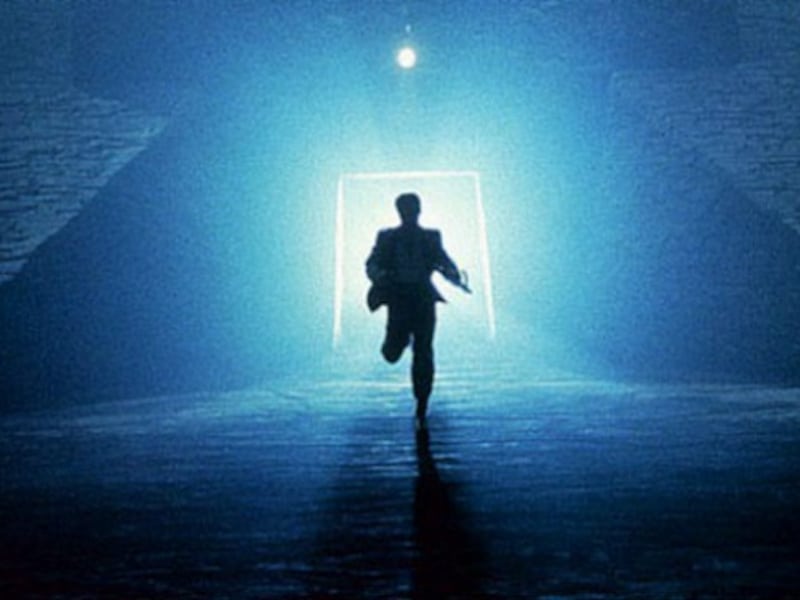Welcome to The Queue — your daily distraction of curated video content sourced from across the web. Today, we’re watching a video that explores the dream-logic of Michael Mann’s The Keep.
True to its name, The Keep is one of the most enigmatic and impenetrable commercial films ever made. lt is also Michael Mann‘s only straight horror film. And what’s remarkable about The Keep, as it sits awkwardly in Mann’s filmography, isn’t that an auteur known for making almost exclusively thrillers directed a horror film. Truly: even amongst horror cinema, this film is an outsider.
Based on F. Paul Wilson’s novel, The Keep takes place in a Romanian village where a forbidding stronghold housing an ancient evil is invaded by a new one. As the Nazis move in, the slumbering, sinewy thing trapped in its depths starts to worm its way out, preying on the desperation of Jewish prisoners and driving the townsfolk mad. Soon we learn that the demon’s awakening has summoned another supernatural entity: a mysterious protector who is, of course, armed with a laser-sword.
Not only is The Keep very, very weird. It is also a film that none of us will ever see. Not really. The version of The Keep that is currently circulating (if you can call it that) is so dissimilar from what its director intended that Mann almost flat-out refuses to talk about it. There are apocryphal rumors, but the gist is that a combination of studio meddling and gross negligence left The Keep in a near-total state of physical and narrative disrepair.
If there is a modern equivalent to the “lost films” of early cinema, it is The Keep. At times it is flat-out indecipherable, both visually and narratively. Most prints of the film look like they were yanked from the mouth of a slobbering dog. While it is possible that Mann is partially to blame for the film failing to come together, it is impossible to watch it and not see the sticky fingerprints of studio execs in every second frame (which might account for the poor image quality).
If you own a copy of The Keep, odds are you found it at the bottom of a well or in the ashes of a bonfire. And that’s part of the film’s appeal: when you watch The Keep it feels as though you’ve stumbled across a cursed VHS tape that someone tried and failed to destroy. Despite, and because of, all its messiness, The Keep really does feel like a waking dream: from its fuzzy logic, passionate heel-turns, and unforgettable, strikingly nightmarish imagery.
The dreaminess of The Keep is especially uncanny because, as Mann himself states in the interview clip below, capturing a dream-like feel was always his intention. Whether the more esoteric parts of the released cut of the film were in fact intentional is something only Mann knows. And he’s not talking. So for the sake of diplomacy, let’s call it a happy accident.
In addition to his dreamy aspirations for The Keep, Mann also discusses, in a glorious Chicago accent, how he fell into filmmaking by taking a supposed throw-away cinema studies course, how his experience in documentary filmmaking sharpened his ear for dialogue, and how he parlayed his first directorial gig.
Watch “Michael Mann on filmmaking, the power of dreams & THE KEEP in 1983 interview“:
Who made this?
This video comes to us courtesy of the Dutch-based film historians over at Eyes on Cinema. Their YouTube channel and Twitter account are essential follows for anyone interested in behind the scenes footage, interviews, and other contextual cinematic ephemera. The footage for the above video comes from an interview taped in 1983.
More Videos Like This
- Here’s the Siskel & Ebert review of The Keep. The phrase “pseudo-profound quasi-supernatural gobbledegook” is uttered and I cannot think of a more divine sequence of words.
- After almost forty years (!) the soundtrack to The Keep is finally getting a wide release. In the meantime, enjoy a taste of Tangerine Dream’s absolutely chilling score.
- How do you market a movie like The Keep? With a pretty rad atmospheric trailer, that’s how.
- In this very informative interview, conducted by Variety chief critic Scott Foundas in 2013, Michael Mann recalls how his prior film, Thief, came to be and discusses the film’s visual style, casting process, and cult soundtrack.

